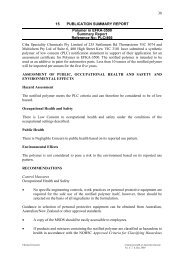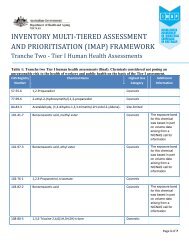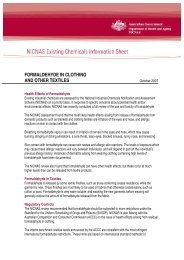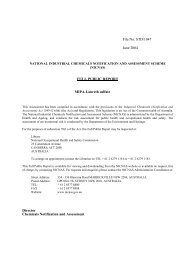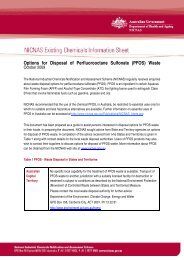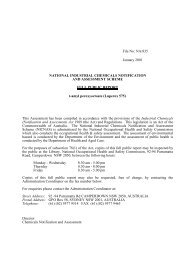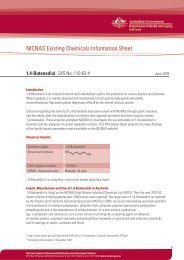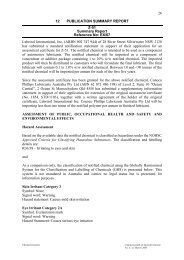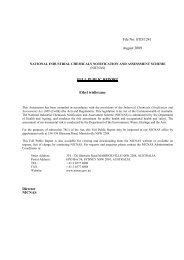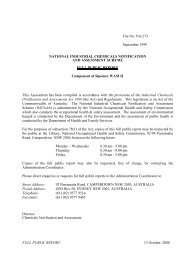GULFTENE C16-18 ISOMERISED OLEFINS - NICNAS
GULFTENE C16-18 ISOMERISED OLEFINS - NICNAS
GULFTENE C16-18 ISOMERISED OLEFINS - NICNAS
Create successful ePaper yourself
Turn your PDF publications into a flip-book with our unique Google optimized e-Paper software.
was also performed according to the protocols of ISO Draft Method ISO/CD11734 (see<br />
above). The results indicated that the extent of biodegradation of the drilling mud reached<br />
28% after 56 days and attained 55% after 70 days. Since the isomerised olefins are the<br />
primary organic component of the “Syn-Teq” fluids, the results of this test indicate that the<br />
isomerised olefins are substantially biodegradable under anaerobic conditions. However,<br />
since the test was not continued beyond 70 days, it is not possible to speculate on the ultimate<br />
degree of degradation which may have been attained. Also, the results were based on an<br />
organic carbon content of 35% in the drilling mud, although no supporting analytical data<br />
accompanied the summary report.<br />
Conclusion<br />
The available data and literature references indicate that Gulftene 16-<strong>18</strong> is probably<br />
susceptible to anaerobic biodegradation when released to the sea floor with waste drill<br />
cuttings. However, the rate and extent of degradation is uncertain, and it is possible that the<br />
rate of removal from the benthic regions will be slow, particularly the case in cold deep<br />
waters. Cobby (1999) indicates that the extent of biodegradation of organic fluids buried in<br />
piles of drill cuttings is limited, and that no substantial long term degradation occurs in these<br />
structures.<br />
8.2.2 ABIOTIC DEGRADATION<br />
Gulftene C14-C20 contains no functional groups capable of hydrolysis, and it is expected that<br />
the major pathways for degradation will be through direct or indirect photochemical<br />
mechanisms.<br />
Hydrogen abstraction by photochemically produced hydroxy radicals is accepted as the<br />
dominant mechanism for degradation of saturated hydrocarbon molecules in the atmosphere,<br />
while in the case of alkenes addition of hydroxy group to the double bond is dominant.<br />
OECD (1992) gives a procedure for calculating typical rate constants for these processes. For<br />
the C14 alkene the estimated rate constant for hydroxyl group addition gives kadd = 56.1 X 10 -<br />
12 cm 3 /molecule/sec, while for hydrogen abstraction from the alkane portion the rate constant<br />
kabs = 12.6 X 10 -12 cm 3 /molecule/sec. Consequently, hydroxyl ion addition is the dominant<br />
initial degradation process, and assuming an ambient hydroxyl radical concentration of 5 x<br />
10 5 radicals/cm 3 , the estimated atmospheric half life is around 2.5 x 10 4 seconds (7 hours).<br />
8.2.3 BIOACCUMULATION<br />
Bioconcentration (Environment & Resource Technology Ltd 1994)<br />
Test Substance: <strong>C16</strong>-C<strong>18</strong> olefin<br />
Determination of the bio-concentration factor (BCF) for the blue mussel Mytilus edulis was<br />
conducted in accordance with OECD Test Guideline 305 A-E. In this procedure the mussels<br />
were exposed to water saturated with the test substance (water temperature <strong>18</strong>.2-<strong>18</strong>.4°C) in a<br />
flow through apparatus for ten days, then allowed to depurate for a period of 20 days.<br />
Samples of water and animal tissue were taken on five occasions during both the exposure<br />
and depuration phases, and analysed for the test substance. Log BCF was calculated from the<br />
rates of uptake and depuration of the compound according to the recommended procedures,<br />
and was determined between 4.1 and 5.4 (BCF between 12 600 and 251 000). These values<br />
FULL PUBLIC REPORT 26 April 2000<br />
NA/713 Page 15 of 100



